Noodlephant: A Conversation with
Jacob Kramer and K-Fai Steele
 December 18th, 2018 by jules
December 18th, 2018 by jules
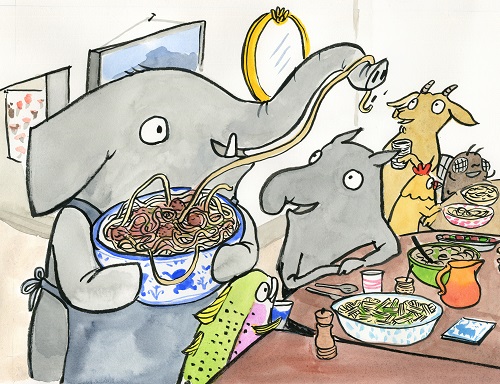
It’s a pleasure to have a visit here today at 7-Imp from author Jacob Kramer and illustrator K-Fai Steele. They are here to chat about their upcoming picture book, Noodlephant (on shelves in January from Enchanted Lion). In fact, this is the debut book for each of them, though 7-Imp readers may remember that K-Fai visited here back in 2017.
This is the story of an elephant, who loves noodles so much that she is famous for her pasta parties and her friends call her Noodlephant. In Noodlephant’s busy town live the kangaroos, always making and enforcing the laws. Unfortunately, the laws are such that they favor the ones in charge. One day, while shopping for a party, a kangaroo notifies Noodlephant that the laws say that noodles are for kangaroos and that “elephants shall only eat sticks and branches.”
Eventually, Noodlephant builds a new kind of pasta-making machine, called the Phantastic Noodler, which can “turn anything into noodles.” The kangaroos find her out; she’s sent to the zoo; and, with the help of her friends, busts her way out. It’s a story about political oppression, community, and creative problem-solving. (10% of the book’s proceeds will be donated to Black and Pink, an organization in support of LGBTQ prisoners that advocates for the abolition of prisons.) Since Jacob and K-Fai are here to discuss it — and K-Fai shares some early sketches and final art — let’s get right to it. I thank them for visiting.

Jules: Hi, you two! Thanks for chatting with me about this book.
Jacob, I’ll start with you: What was the genesis of this story about confronting and fighting injustice?
Jacob: Hi, Julie! Really nice to meet you! Thanks for this wonderful opportunity.
The initial spark came from my nephew Leo, who invented the idea of elephants who love noodles and funny sauces. In re-writes, our editor, Claudia Zoe Bedrick, asked: What it is Noodlephant is committing to make happen through noodles?
It made me wonder about myself, too. What am I committing to make happen? This was the spring and early summer of 2016, and I was thinking about state violence and how our unjust criminal punishment, caste systems, austerity, and oligarchy keep ordinary people from thriving. But I was also thinking about all the good stuff that we marshal in opposition to those things — community, creativity, resourcefulness, and rebelliousness. So, the challenge became trying to show these forces at play in the context of a picture book and in a way that was true to Noodlephant’s character.

She loved to mix whole bags of semolina flour with dozens of eggs,
delighting her guests with noodles of all shapes and sizes.”
(Click to enlarge spread)
Jules: K-Fai, what was your initial response to the story?
K-Fai: I’m interested in picture books that are character-driven and, in particular, stories that show how a character struggles against larger forces in the world. Also, I just have a ton of fun drawing characters, especially animals with strong human characteristics, so I was really excited to read Jacob’s first drafts of Noodlephant.
As an illustrator, getting the manuscript and developing the visual world that characters live in is one of the most heady, marvelous parts of the process (as opposed to the slow agony of edits). I love getting to know a character and her world, and I developed Noodlephant almost instantly; I knew I wanted her to be big, almost too big for her cramped, run-down apartment that was full of art and books and dirty dishes from dinners with friends.
Jacob and I are friends, as well as colleagues, and we talked about the process of creating Noodlephant as we went along. I don’t think a lot of people know that this is exactly what many publishers don’t want you to do; it tends to gum up the works. But Jacob and I have a deep level of respect and understanding for each other’s work and what we as individuals bring to the table.
(I also read Wild Things! while I was developing the sketches for Noodlephant. I pored over it, and I see what we’re doing with Noodlephant to be very much in company and in conversation with your book.)
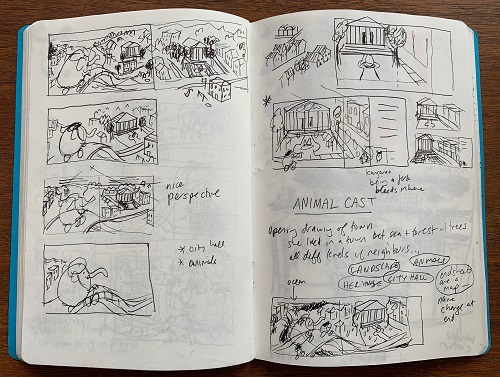
(Click to enlarge)
Jules: Jacob, what was it like to see her first sketches and such?
Jacob: Of course, when K-Fai showed me the initial sketches of Noodlephant (making pasta, I think?), I was thrilled. There she was, larger than life! It’s astounding how much personality K-Fai evokes with just a few lines. We had already been collaborating for a while on illustrated poems, so I had a sense of how great her work is. But she really pulled out all the stops for Noodlephant and went far beyond any expectation. Each character in the book has their own reactions, relationships, and trajectory. K-Fai has a particular genius for translating humans into animals and vice-versa. To call it anthropomorphism would be a misnomer; it’s a deeper commitment to the essential continuity between living things.

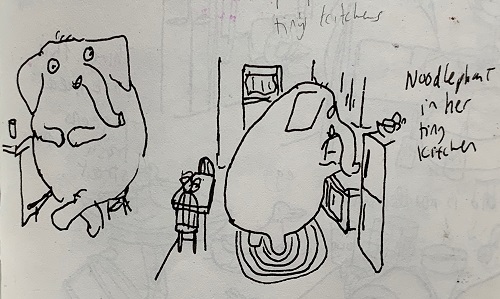
(Click each to enlarge)
Jules: I hadn’t realized you two had collaborated previously. How did that come about?
K-Fai: The short story is that Pennie, who is Jacob’s partner, introduced us and we now have a lot of common friends. The long story, and the one that I think is interesting, is that making stuff with friends and people in your community is an intensely satisfying thing to do, whether it’s making food, drawings on a diner placemat, a collective campaign for neighborhood council, or a picture book.
Jules: Has either one of you shared this story with children in school settings yet? (I’m probably asking a bit early, since it’s not on shelves quite yet.) I would think children are going to love and truly appreciate: “When the laws are so unjust / Misbehavior is a must!”
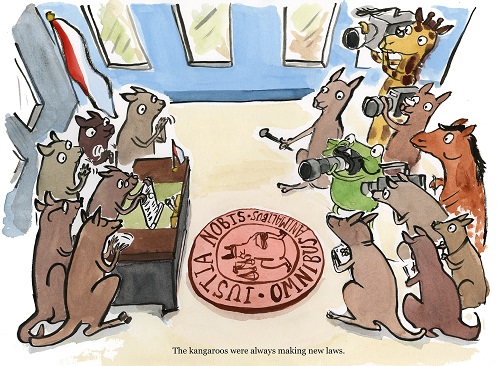
(Click to enlarge)
Jacob: Over the summer, during ALA in New Orleans, I brought some of our mini-galleys to an arts summer camp where my friends are counselors. This is a place where they made an internal postal system and build obstacle courses for squirrels. It’s outrageously cool. Reading Noodlephant to kids of mixed ages, it was fun to see how even 5th- and 6th-graders were engaging. Maybe they were humoring me. But I also think the themes resonated. Kids are subject to lots of authority, so they have an immediate sense of fairness. What I like about our book is that it doesn’t simply provoke; it shows a way forward via collective action.
One of the younger kids memorably asked, “Why does the zoo look like a jail?” It led to a conversation about how we feel about caging humans and other animals. I think it kind of blew her mind to look at zoos from a different perspective. This was also at a moment when the ongoing separation and jailing of refugee children was front-page news. It made us realize how unfortunately relevant this story will be — and think about how it can fit into curricula about civics and current events. We’re interested in developing lesson plans and activities to help with that.
Jules: Let’s talk character a moment. Jacob, can you talk about the cast of characters here and the process of building the animal community? How did you determine, for instance, that the kangaroos would be the “very, very bossy” ones?
And, K-Fai, did you use watercolors for this? Were any other books/characters inspirations, by chance (even if distantly), for this book’s aesthetic?
K-Fai: I did use watercolors to make the book. Fun fact: I actually made most of the watercolors I used (in that I mixed/mulled pigment with watercolor medium to make the paint).
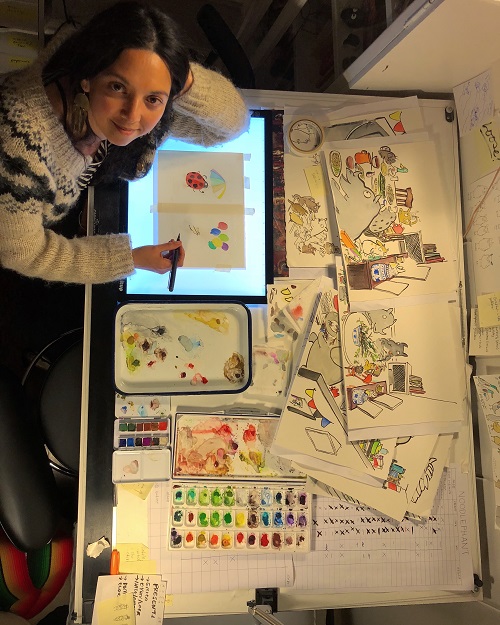
I can’t name any picture books or characters that directly inspired the book’s aesthetic — not that they don’t exist. I just can’t name one. I’ve been told I have a distinctive style, which is probably the result of me spending most of my time in museums and libraries taking bits and pieces of everything and mixing it all up. Most of all, I love drawing and developing characters, because I really get to know them and their personalities through their gestures. I’ve always loved to make people I love laugh, and one of my favorite things to do is doodle new characters with someone while, for example, waiting for food at a restaurant. Catch me at the right time and we’ll make a little story together.
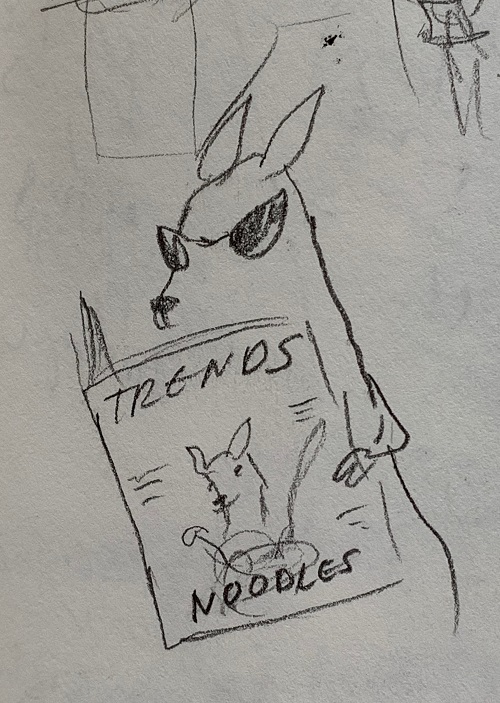
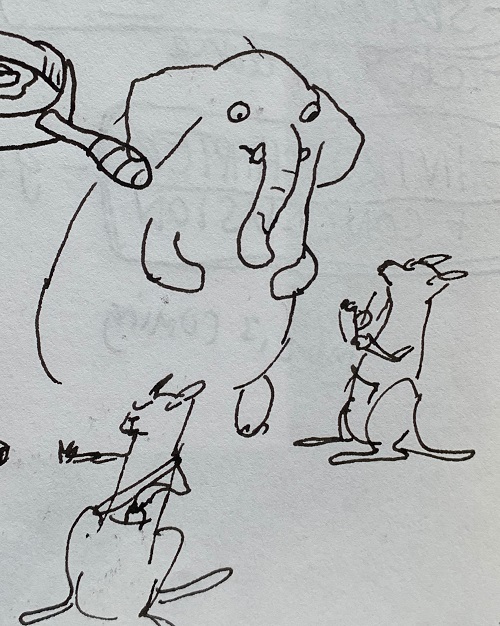
Jacob: In terms of building the Rooville community, that was all K-Fai. The words are pretty open-ended. I write that Noodlephant “had neighbors of all sorts. Some had fur, some were smooth. Some could roll and some could fly.” K-Fai really ran with it. One of the most amazing things is how she has a range of species, ages, and socioeconomic strata. You can see the wealth disparities — where the kangaroos live in stand-alone houses near downtown, and the other animals across the river are in row houses or apartments near the zoo.
As for the kangaroos, I cast them as the bossy antagonists for a few reasons, mostly to do with language. There were a couple built-in jokes that I liked; they have “deep pockets” and of course they have an unfair system of “kangaroo courts.” The line “those kangaroos are kanga-rude” sprang to mind, and it helps that kangaroo rhymes with “zoo.” The fact that they’re bipedal also made me think of them as officious. I hope the true kangaroo-heads out there don’t take offense!

(Click to enlarge spread)

They said she had broken the laws. Noodlephant said the laws were already broken.”
(Click to enlarge)
Jules: Jacob, how much fun was it to include the verses you have in the text — the moments where they sing as they work (though Noodlephant also speaks in verse when she is in court and as she’s being led away to jail)? I am imagining children chanting, “‘Cause noodles are for me’s and you’s! We won’t be locked up in the zoos.”
Also, I love how they share, in the end, with the kangaroos. I like how the kangas see the light. It takes the story out on a lovely, hopeful note.
Jacob: Including verse is so fun! I’m baffled when I see editors with “no rhyming” policies. How stodgy! When you get the meter and rhyme working together, it can make a concept feel just right. It’s a rhetorical flourish that seemed fitting for Noodlephant and her friends. I’ve even experimented with it a bit in my own advocacy: I gave some testimony in verse last spring, and I think it made a memorable impression on our local government!
I’m so glad you liked the ending. It’s a gentle sort of revolution — the kangaroos have every incentive to go along with the majority, and they wisely concede without a fuss. In terms of conflict resolution, there’s an odd parallel between feasting and fighting; I greatly prefer the former to the latter.
Jules: I love that big feast at the end. I have a thing for picture book feasts, my very favorite being the one in John Burningham’s Mr. Gumpy’s Outing.
Thank you both for chatting with me about this book. I’ll close with, arguably, the most pressing question: do either of you have a belly button shaped like a tortellino (just like Noodlephant)?
Jacob: Alas, my bellybutton is not so shapely as that of the goddess Venus, whose sacred ombellico inspired a Bolognese innkeeper to fold the first tortellino so very long ago.
Great chatting with you, too!
Ed. Note: K-Fai recently wrote about her experience as the 2018 Ezra Jack Keats/Kerlan Memorial Fellowship recipient. You can read her wonderful post here.
NOODLEPHANT. Text © 2019 by Jacob Kramer. Illustrations © 2019 by K-Fai Steele. Published by Enchanted Lion Books, Brooklyn. All images here reproduced by permission of K-Fai Steele.

Love it 🙂